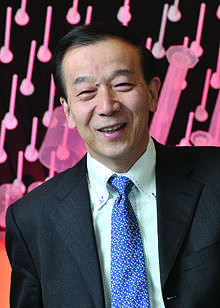Yusuke Nakamura (geneticist)
Yusuke Nakamura (中村 祐輔, Nakamura Yūsuke, born 8 December 1952) is a Japanese prominent geneticist and cancer researcher best known for developing Genome-Wide Association Study (GWAS). He is one of the world's pioneers in applying genetic variations (Variable Number Tandem Repeat (VNTR) and Single Nucleotide Polymorphism (SNP) markers) and whole genome sequencing, leading the research field of personalized medicine.[1]
Yusuke Nakamura | |
|---|---|
 | |
| Born | December 8, 1952 Osaka Prefecture, Japan |
| Nationality | Japanese |
| Alma mater | Osaka University |
| Known for | Deveopment of Genome-Wide Association Study (GWAS) Identificaion of Tumor Suppressor Gene APC and Variable Number of Tandem Repeat (VNTR) markers |
| Awards | Keio Medical Science Prize (2000) |
| Scientific career | |
| Fields | Molecular genetics Cancer research |
| Institutions | Japanese Cabinet Office University of Chicago RIKEN University of Tokyo Japanese Foundation for Cancer Research University of Utah |
Scientific Contribution
Nakamura successfully identified VNTR markers in 1987[2] and tumor suppressor gene APC in 1991.[3] Furthermore, several genetic polymorphic markers developed and mapped by his research groups at the Japanese Foundation for Cancer Research and the University of Tokyo, have contributed to map and clone genes responsible to hereditary diseases, as well as those related to drug response and involved in cancer.
In 2001, Nakamura and his colleagues of RIKEN SNP Research Center developed the methodology of Genome-Wide Association Study (GWAS),[4] and using this method his research gourp first discovered functional SNP in the lymphotoxin-α gene that are associated with susceptibility to myocardial infarction in 2002, which was a breakthrough in the research field of medical genetics.[5] Furthermore, the RIKEN SNP Research Center led by him made the largest contribution in the Phase 1 HapMap project of the International HapMap Consortium published in the scientific journal Nature in 2005.[6]
Nakamura has also focused on applying genetic information to improve the care of cancer patients, working to bring his laboratory's discoveries into the clinical practice. In 2001, his cancer research at the University of Tokyo led to the formation of OncoTherapy Science, a successful public Japanese biotechnology company that concentrates on new cancer therapies.
Life and career
Nakamura was born in Osaka, Japan on 8 December 1952.[7] He received his medical degree in 1977 and his PhD in 1984 from Osaka University. While working as a surgeon in Japan, he witnessed a 27-year-old patient die of cancer, which affected him deeply.[8] Then, to pursue advanced study in genetics and oncology, he went to the US and spent five years as a postdoctoral fellow and then as a faculty member at the Howard Hughes Medical Institute at the University of Utah, an international center for gene mapping.
In 1989, Nakamura became Head of the Biochemistry Department, at the Cancer Institute, Japanese Foundation for Cancer Research.[7] He was appointed as Professor at the Institute of Medical Science, University of Tokyo in 1994. When the Japanese government launched its Millennium Genome Project in 2000, he was named group leader for the genetic diversity program at the renowned RIKEN SNP Research Center. He also served as director of the RIKEN Center from 2005 to 2010, as well as Director of National Cancer Research Research Institute from 2010 to 2011. From January to December 2011, Nakamura was Special Advisor to the Cabinet Secretary General, Office of Medical Innovation, Cabinet Secretariat, Government of Japan.[7]
In 2012, Nakamura moved to the Department of Medicine at the University of Chicago in 2012 as Professor and Deputy Director, Center for Personalized Therapeutics[7] In 2018, after becoming the Emeritus Faculty Professor of the University of Chicago and returning to Japan, he was appointed Director of Cross-ministerial Strategic Innovation Promotion Program of Japanese Cabinet Office, as well as Director at the Cancer Precision Center, Japanese Foundation for Cancer Research.
Awards
Nakamura received several honors and awards include the following.
- 1992 Princess Takamatsu Cancer Research Award
- 2000 Keio Medical Science Prize for "Elucidation of various genetic diseases through human genome analysis"[9]
- 2002 Tomizo Yoshida Award of the Japanese Cancer Association
- 2004 Japanese Medal of Honor with purple ribbon
- 2010 Chen Award for Distinguished Academic Achievement in Human Genetic and Genomic Research, Human Genome Organization (HUGO)[10]
References
- "Yusuke Nakamura, Department of Medicine Faculty". Archived from the original on 2014-02-22. Retrieved 2014-02-12.
- Nakamura, Y; Leppert, M; O'Connell, P; Wolff, R; Holm, T; Culver, M; Martin, C; Fujimoto, E; Hoff, M; Kumlin, E (1987). "Variable number of tandem repeat (VNTR) markers for human gene mapping". Science. 235 (4796): 1616–22. Bibcode:1987Sci...235.1616N. doi:10.1126/science.3029872. PMID 3029872.
- Kinzler, K. W.; Nilbert, M. C.; Su, L. K.; Vogelstein, B; Bryan, T. M.; Levy, D. B.; Smith, K. J.; Preisinger, A. C.; Hedge, P; McKechnie, D (1991). "Identification of FAP locus genes from chromosome 5q21". Science. 253 (5020): 661–5. Bibcode:1991Sci...253..661K. doi:10.1126/science.1651562. PMID 1651562.
- Ohnishi, Y.; Tanaka, T.; Ozaki, K.; Yamada, R.; Suzuki, H.; Nakamura, Y. (2001). "A high-throughput SNP typing system for genome-wide association studies". Journal of Human Genetics. 46 (8): 471–7. doi:10.1007/s100380170047. PMID 11501945.
- Ozaki, K.; Ohnishi, Y.; Iida, A.; Sekine, A.; Yamada, R.; Tsunoda, T.; Sato, H.; Sato, H.; Hori, M.; Nakamura, Y.; Tanaka, T. (2002). "Functional SNPS in the lymphotoxin-alpha gene that are associated with susceptibility to myocardial infarction". Nature Genetics. 32 (4): 650–4. doi:10.1038/ng1047. PMID 12426569.
- International HapMap Consortium (2005). "A haplotype map of the human genome". Nature. 437 (7063): 1299–320. Bibcode:2005Natur.437.1299T. doi:10.1038/nature04226. PMC 1880871. PMID 16255080.
- Yusuke Nakamura MD PhD
- "I would like to cure cancer". Retrieved 2017-10-07.
- The 2000 Keio Medical Science Prize Awardees
- Chen Award for Distinguished Academic Achievement in Human Genetic and Genomic Research (2010)